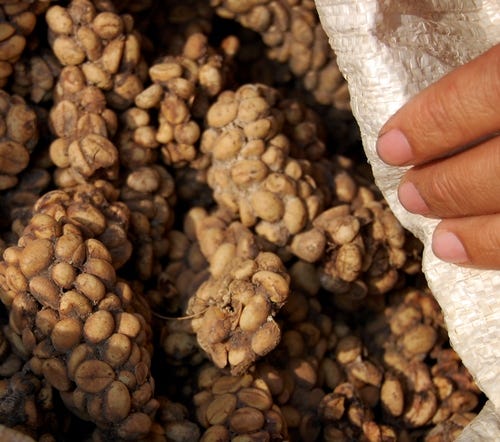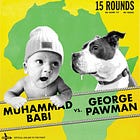On coffee, civets and faeces
In my last post, I noted that my lengthy list of potential Substack posts includes one on coffee shat out the bums of monkeys—a topic that has intrigued me for well over twenty years. Well, it turns out that the coffee is not shat out the bums of monkeys at all, but civets (thanks to Daniel Michoux for bringing this to my attention). That I have confused monkeys and civets will surprise none of my former colleagues at the University of Roehampton, amongst whom my ignorance of the fundamentals of biology and zoology was legendary.
This post is dedicated to the memory of the zoologist Peter Shaw, whose faith in my intelligence was sadly shaken after I assumed that a springtail was a type of bird (for those equally ignorant, it’s most definitely not), but who I’m sure would have had much to contribute to my thinking on civet turd coffee, in the event that I’d thought to raise the topic in a lunchtime debate.
I first learned about coffee shat out the bums of monkeys while visiting my sister in Vancouver in 2002. When she told me about an extortionately expensive coffee harvested from animal turds that was being sold at a posh local supermarket, I refused to believe her. She took me into the supermarket to prove it and, sure enough, the coffee was prominently displayed near the store entrance, and was just as extortionately priced as my sister had promised. I can’t recall now exactly how much it cost for a packet, but I think it was well north of $100.
The coffee in question is called kopi luwak, and it actually comes out the arses of civets rather than monkeys1—civets being a type of nocturnal mammal native to the Asian tropics and sub-Saharan Africa. You see, civets in Indonesia have a fondness for the small, cherry-like fruit that grows on coffee plants. They eat the fruit and swallow the beans, which then pass through their digestive tract and emerge largely intact on the other side—kind of like corn2—but allegedly with an enhanced flavour, due to the enzymes in the civet’s stomach. To quote Harrods, which currently sells civet coffee for £500 per 250g packet, this digestive process produces a brew ‘deliciously rich with notes of red apple, chocolate and citrus’.
Apocryphal stories abound of how civet coffee was discovered. The most widely circulating account is that during the Dutch colonial period, the Dutch introduced both coffee plantations and a strict system of quotas for production that forbade workers to partake of coffee beans themselves. In response, locals, who had acquired a taste for coffee, started secretly extracting beans from civet dung as a way of getting around the rules, discovering in the process the deliciousness of the resultant brew.
This story was also recounted to the anthropologist Colin Cahill during his doctoral fieldwork with Indonesian civet coffee producers, although he notes that its source appeared to be newspaper reports as much as family oral history. Locals informed him that the secret of civet coffee inevitably spread from locals to the Dutch, where ‘it quickly became a secret drink of the elites and the Dutch royalty’.
Claims of a secret elite passion for civet coffee aside, according to Cahill’s overview of the history of civet coffee production, the coffee was initially marketed as a novelty drink to tourists along backpacker networks in Indonesia in the late 1990s. This basically makes it the equivalent of crocodile meat, which has long been sold in tourist traps in Australia as a novelty food.3 However, around the turn of the 21st century, civet coffee began to attract the attention of journalists, who helped to give it international exposure and establish its reputation as an exclusive delicacy.
Coffee aficionados frequently claim that genuine civet coffee is ambrosial in flavour. For example, according to the food writer Tim Hayward,
‘On first taste it’s pretty fantastic with all of the higher notes you tend to get with a well-roasted bespoke coffee but the defining characteristic is a lovely, long, subtly nutty aftertaste4 that looks like it’s going to carry on right through to the bacon sandwich I’m lining up as breakfast’.
However, there’s little question that the exclusivity of civet coffee explains a large part of its global appeal.
As Cahill experienced firsthand, civet coffee is highly labour intensive to produce. Once the dung is collected from civets, it must be dried out, strained and sorted, and then, depending on the preference of the buyer, hulled and roasted. However, this exclusivity has been threatened by higher levels of production since 2008, much of which has been accomplished via the use of caged civets. This has led to a growing emphasis on civet coffee produced by ‘wild’ rather than ‘caged’ beasts.
For example, Harrods states that its kopi luwak coffee beans ‘are sourced from 100% wild animals; our supplier’s specialist team of foragers gather the coffee beans, which are left behind in the forest’. Although the veracity of such claims has been disputed, the emphasis on wild civet coffee stems not just from reports highlighting the grim living conditions of many caged civets, but the rarity of wild civet coffee, which is accompanied by assertions of their more discriminating coffee bean palate. In effect, what we are seeing is the ways in which the type of coffee you drink—and even the type of civet coffee you drink—operates as a form of distinction.
As I’ve previously discussed, this is the term used by the sociologist Pierre Bourdieu to describe the ways in which differences in taste become the basis of social judgement. One of Bourdieu’s key insights was that while we think of taste as something natural and personal, it’s also thoroughly social, and a key means through which social class is reproduced.
Food tastes have long been a key form of social distinction. In fact, although I have previously claimed that wine is unrivalled in the degree of posturing it produces, it’s possible that coffee outpaces it. This is primarily because coffee consumption operates as a form of distinction not just on the basis of the type of coffee you purchase and where it’s from, but the way you prepare it and the accoutrements you use to do so. It’s not a coincidence that in the 2007 film The Bucket List, civet coffee is the beverage of choice of billionaire Edward Cole, while his working-class hospital and travel companion, the retired mechanic Carter Chambers, prefers the instant variety.
Although the source of civet coffee’s distinctive taste and aroma is revealed towards the end of the film, it doesn’t appear to have hurt global kopi luwak sales. If anything, it arguably bolstered them, given the upswing in production from 2008. This suggests that the faecal origins of civet coffee are not incidental to its appeal. As Cahill observes, consumers want to be assured that civet coffee is ‘both safe for consumption and authentically fecal in origin’.
Indeed, Cahill notes that some international buyers request semi-processed beans—i..e, beans that remain encased in faeces—to assure themselves of their authenticity.5 Moreover, not all faeces are equal in the eyes of buyers. Instead, robust turds that look like they’ve travelled through the intestinal cavity are prized more than ones of the diarrhoeal variety that have ‘lost the integrity of their form’. In effect, robust faecal matter acts as a guarantor of the integrity of the coffee beans as ‘real’, ‘authentic’ civet coffee.
If Mary Douglas is right that matter stemming from the margins of the body is simultaneously polluting and powerful, it’s not all that surprising that coffee beans derived from civet faeces might be seen to have unique qualities. As I’ve previously discussed in relation to urine, its perceived power is evident in the notion that it taints the surfaces it comes into contact with and the supposition that the ‘golden fountain’ is a miracle cure for all sorts of medical ailments.
The anthropologist Matthew Wolf-Meyer has recently argued that while bodily excretions like faeces disgust us, this disgust isn’t necessarily ‘settled’. Indeed, one only needs to consider beauty treatments to realise the positive power that bodily emissions potentially hold, as the recent celebrity trend for salmon sperm facials attests. Salmon sperm facials join a long line of beauty treatments—from snail mucus to pig, cow, sheep and human placenta, nightingale turds, and even, on occasion, human faeces itself—whose perceived power seems to reside primarily in the fact that they are excreted or ejaculated by animals.
While faeces might be the most polluting of all excretions, it’s clearly valued in certain circumstances as well. Cahill points to its long history as a fertiliser, but it is also increasingly being used in medical contexts. This is most evident in the rise of faecal microbiota transplantation (FMT): a procedure in which microbiota from a healthy donor’s stools are transplanted to people with unhealthy gut bacteria, although it’s now also being explored as a cure for depression.6 As Wolf-Meyer notes, FMT requires patients to learn that ‘Shit can become medicine through its microbial ingredients’.
In the end, it seems to me that the story of civet coffee is less unique than I initially thought. Instead of revealing some new quirk of human behaviour, it is instead a story as old as time—or at least as old as humans themselves. It might be in our nature to classify the world around us and to notice and fear boundaries, but it’s also in our nature to cross them. This means that while our first thought when we look at a turd is, ‘Ew, gross!’, we then take a second look and think, ‘You know what? That might make a delicious drink—and I bet Joe Bloggs up the road hasn’t thought of doing it’.
Related posts
In my defence,* it’s possible that the internet led me astray, as civet coffee is often mislabelled ‘monkey butt coffee’ and attributed to Sumatran monkeys. However, it’s also possible that I was confusing two different types of coffee associated with the digestive tracts of mammals, because The Spruce Eats discusses a type of coffee from Taiwan and India that is processed by rhesus monkeys and Formosan rock macaques, who chew the beans and then spit them out. In the event that you are interested in what the digestive juices of mammals do to coffee beans but don’t have £500 to drop at Harrods, it appears to be significantly cheaper than kopi luwak.
*And mostly because I don’t like admitting I’m wrong.
Although also kind of not. While those of us in the habit of examining our faeces have often had cause to observe that corn looks much the same going into the mouth and out the bum, this is an illusion caused by the fact that we process the innards of the corn but not the shell itself. The point is that in the unlikely event you desired to do so, you would not be able to reconstitute the corn for future consumption.
Interestingly, it too has recently had a rebrand as a delicacy—at least, according to Chef Pencil, although I suspect this would be news to most Australians.
Call me a philistine, but I like to get my nutty aftertaste from actual nuts. (Er, real nuts, obviously, not the euphemistic variety.)
It hasn’t escaped my notice that coffee-filled civet dung looks remarkably similar to a rustic version of a Picnic bar. The resemblance of turds to chocolate bars was first brought to my attention in the pool scene in Caddyshack, and once the visual connection has been made it cannot be unseen.
It’s therefore entirely possible that the plethora of books on the ‘golden fountain’ will ultimately be joined by books on the ‘brown nugget’.








